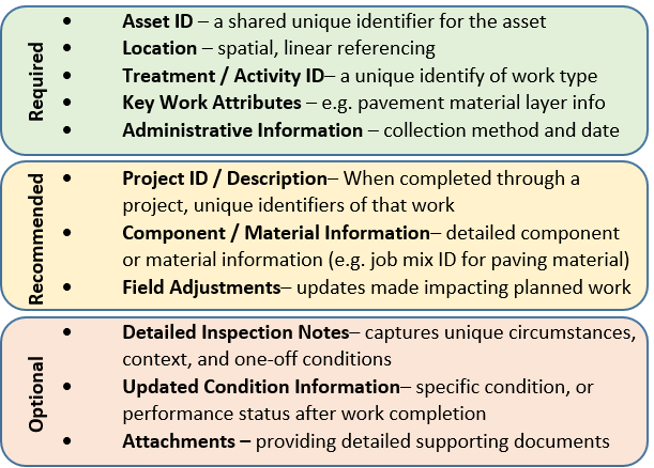Required and recommend fields should be feasible to collect and maintain; optional fields may only be collected under specific circumstances. Data that cannot be reliably collected or maintained should be excluded from the data model elements.

Examine asset management decision-making needs to establish clear requirements to what extent treatment or work history data attributes will be collected (e.g. Interstate work history may be required, while other work may not be captured).
Balance the cost of tracking treatment information against the value it will add to decision making. For example, it may be costly to record itemized, location-specific information about certain minor or routine maintenance activities, if they can be tracked in a more aggregated manner and provide the needed information.
Asset treatment and work can be captured by work location (e.g. paving on particular route between specific mile points) or against the asset inventory (e.g. rehabilitation of a specific bridge). In some cases, geographic or organizational-level (e.g. county-wide summary) or contract or project-level information is sufficient. For each work type, consider and incorporate the necessary level of granularity for tracking into the data model and collection requirements.

The following terms are used within this Section.
Standard rules for data transfer between project design, delivery, and asset life-cycle management systems and/or process participants.
As defined by the ISO 19650 standard, a model developed during project design and construction that begins as a design intent model, and then evolves to be a virtual construction model.
The type and quantity of completed work on assets (e.g. inspections, repairs, or replacements); may include other information such as date completed, whether the work was performed by state forces or contract, resources used, and cost.
When spot repairs to the guardrail rail sections do not impact the overall guardrail system length, configuration, product type, or functional condition, detailed work or project information may not be necessary for asset management purposes. This can be reflected in the data model and requirements.
Planned paving activities may be subject to field adjustment – project limits may be shortened or extended, paving sections added or removed, or treatment material types or thickness may be modified based on prevailing field conditions or available funding. For certain activities, it may only be necessary to reflect adjustments to the work location (where treatment details are unlikely to change – e.g. patching). In other cases, detailed treatment information may need to be captured in the field (to ensure accuracy of critical information, such as material types and thicknesses). Consider these circumstances when establishing detailed field data collection data models and requirements.